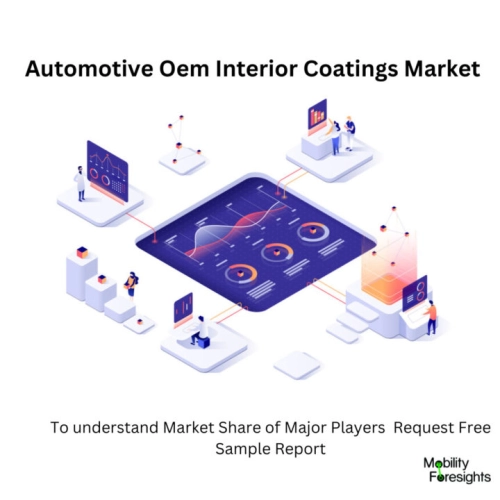
- Get in Touch with Us

Last Updated: Apr 25, 2025 | Study Period: 2023-2030
Automotive OEM interior coatings are specialized coatings that are applied to the inside components of vehicles during the production process.
These coatings serve a range of functions, from boosting operation and longevity to improving aesthetics.
They are critical in assuring the interior's quality, comfort, and safety.
Soft-touch coatings are used on areas that occupants regularly contact, such as dashboard panels, steering wheels, and armrests.
These coatings provide a pleasant tactile experience by simulating the feel of soft materials such as leather or suede.
Anti-glare coatings are frequently used on surfaces such as dashboard tops and instrument clusters.
They serve to reduce glare from the sun, improving sight for the driver and overall safety.
High-contact surfaces, such as door knobs and control buttons, can wear significantly over time.
Scratch- and wear-resistant coatings help to maintain the appearance of these components and extend their lifespan.
Interior coatings for automobiles are designed to meet stringent industry standards for safety, durability, and environmental effect.
Coatings are chosen based on elements such as vehicle model, interior design, intended use, and regulatory requirements.
Manufacturers carefully select and apply these coatings to ensure that the interior of the vehicle satisfies high quality requirements and that passengers have a pleasant driving and riding experience.
These coatings are used on fabrics and upholstery to repel liquids and prevent stains.
This is especially effective in preventing spills from causing permanent damage to the interior.

The automotive oem interior coatings accounted for $XX Billion in 2022 and is anticipated to reach $XX Billion by 2030, registering a CAGR of XX% from 2023 to 2030.
Nippon Paint Automotive Coatings Co., Ltd. introduces dry film coating technology to meet the needs of customers in the automotive sector for innovative and sustainable coatings.
The world's foremost automotive coatings congress drew notable delegates from key multinational automakers and suppliers, as well as respected research organizations.
Nippon Paint Automotive Coatings and Taikisha Group presented "Dry Film Coating: New Generation Coating Method in Automotive Manufacturing" at SURCAR Detroit.
As a result, controlling energy usage in the painting process becomes crucial to improving energy efficiency and lowering emissions throughout the whole automotive manufacturing facility.
This emphasizes the critical role of novel coating technologies in reducing energy usage during the painting process.
| Sl no | Topic |
| 1 | Market Segmentation |
| 2 | Scope of the report |
| 3 | Abbreviations |
| 4 | Research Methodology |
| 5 | Executive Summary |
| 6 | Introduction |
| 7 | Insights from Industry stakeholders |
| 8 | Cost breakdown of Product by sub-components and average profit margin |
| 9 | Disruptive innovation in the Industry |
| 10 | Technology trends in the Industry |
| 11 | Consumer trends in the industry |
| 12 | Recent Production Milestones |
| 13 | Component Manufacturing in US, EU and China |
| 14 | COVID-19 impact on overall market |
| 15 | COVID-19 impact on Production of components |
| 16 | COVID-19 impact on Point of sale |
| 17 | Market Segmentation, Dynamics and Forecast by Geography, 2023-2030 |
| 18 | Market Segmentation, Dynamics and Forecast by Product Type, 2023-2030 |
| 19 | Market Segmentation, Dynamics and Forecast by Application, 2023-2030 |
| 20 | Market Segmentation, Dynamics and Forecast by End use, 2023-2030 |
| 21 | Product installation rate by OEM, 2023 |
| 22 | Incline/Decline in Average B-2-B selling price in past 5 years |
| 23 | Competition from substitute products |
| 24 | Gross margin and average profitability of suppliers |
| 25 | New product development in past 12 months |
| 26 | M&A in past 12 months |
| 27 | Growth strategy of leading players |
| 28 | Market share of vendors, 2023 |
| 29 | Company Profiles |
| 30 | Unmet needs and opportunity for new suppliers |
| 31 | Conclusion |
| 32 | Appendix |